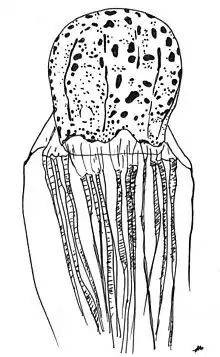| Chirodectes | |
|---|---|
 | |
| illustration of Chirodectes maculatus | |
| Scientific classification | |
| Domain: | Eukaryota |
| Kingdom: | Animalia |
| Phylum: | Cnidaria |
| Class: | Cubozoa |
| Order: | Chirodropida |
| Family: | Chirodropidae |
| Genus: | Chirodectes Gershwin, 2006[1] |
| Type species | |
| Chirodectes maculatus (Cornelius, Fenner & Hore, 2005) | |
Chirodectes is a very rare, monospecific genus of box jellyfish in the family Chirodropidae.
The first and only scientifically studied specimen was captured from the outer edge of the Great Barrier Reef – about 43 km (27 mi) off the coast of northeast Queensland – on 2 May 1997.[2] It was found within 5 metres (16 ft) of the surface, and the researchers who first described it speculated that it may have been relocated to the area by Cyclone Justin.[2] Its bell measured approximately 15 cm (5.9 in) in height, and it could only be observed for several hours in an examination lab due to how delicate it was.[2]
There are no recorded cases of a human sting from Chirodectes as it "failed either to sting, or adhere to, the hand and forearm of an incautious volunteer" during the examination, but it is assumed – due to its relatively large size and to the extremely venomous nature of some chirodropids – that Chirodectes is itself venomous.[2] A video of the Chirodectes was recorded underwater before it was collected. Four photos captured from the original 1997 video were published in the scholarly journal Memoirs of the Queensland Museum in 2005.[2]
In 2022, a jellyfish was filmed by a scuba diver off the coast of Papua New Guinea, which prompted Lisa-ann Gershwin, the marine biologist who first described the genus Chirodectes, to examine the video. A frame-by-frame comparison between the 1997 and 2022 videos convinced Gershwin that the latter likely depicts a new species; however, as of August 2022, it has yet to be formally classified, and a paper has not been submitted for peer review.[3][4]
Taxonomy
Chirodectes was created in 2006 from C. maculatus, a species originally in the genus Chiropsalmus.[1]
Species
The following species are in this genus:[5]
- Chirodectes maculatus (Cornelius, Fenner & Hore, 2005)
References
- 1 2 Gershwin, Lisa-Ann (12 June 2006). "Comments on Chiropsalmus (Cnidaria: Cubozoa: Chirodropida): a preliminary revision of the Chiropsalmidae, with descriptions of two new genera and two new species". Zootaxa. 1231 (1): 1–42. doi:10.11646/zootaxa.1231.1.1 – via ResearchGate.
- 1 2 3 4 5 Cornelius, Paul F. S.; Fenner, Peter J.; Hore, Russell (31 December 2005). "Chiropsalmus maculatus sp. nov., a cubomedusa from the Great Barrier Reef". Memoirs of the Queensland Museum. 51 (2): 399–405. ISSN 0079-8835 – via the Biodiversity Heritage Library.
- ↑ Favazzo, Lisa (4 August 2022). "'Magnificent' jellyfish found off coast of Papua New Guinea sparks interest among researchers". The Guardian. Archived from the original on 7 September 2022. Retrieved 11 September 2022.
- ↑ Brandel, Phil (2 August 2022). "Jellyfish filmed by scuba diver off Papua New Guinea could be rare or new species". ABC News. Archived from the original on 6 September 2022. Retrieved 11 September 2022.
- ↑ Collins, Allen G. (2010). "Chirodectes Gershwin, 2006". WoRMS. World Register of Marine Species. Retrieved 25 May 2015.
Video found on twitter: https://twitter.com/waterlsscary/status/1680180234908479491?s=52&t=o66y4GSAg8Qd9thUXBy7qA
External links
 Media related to Chirodectes at Wikimedia Commons
Media related to Chirodectes at Wikimedia Commons Data related to Chirodectes at Wikispecies
Data related to Chirodectes at Wikispecies